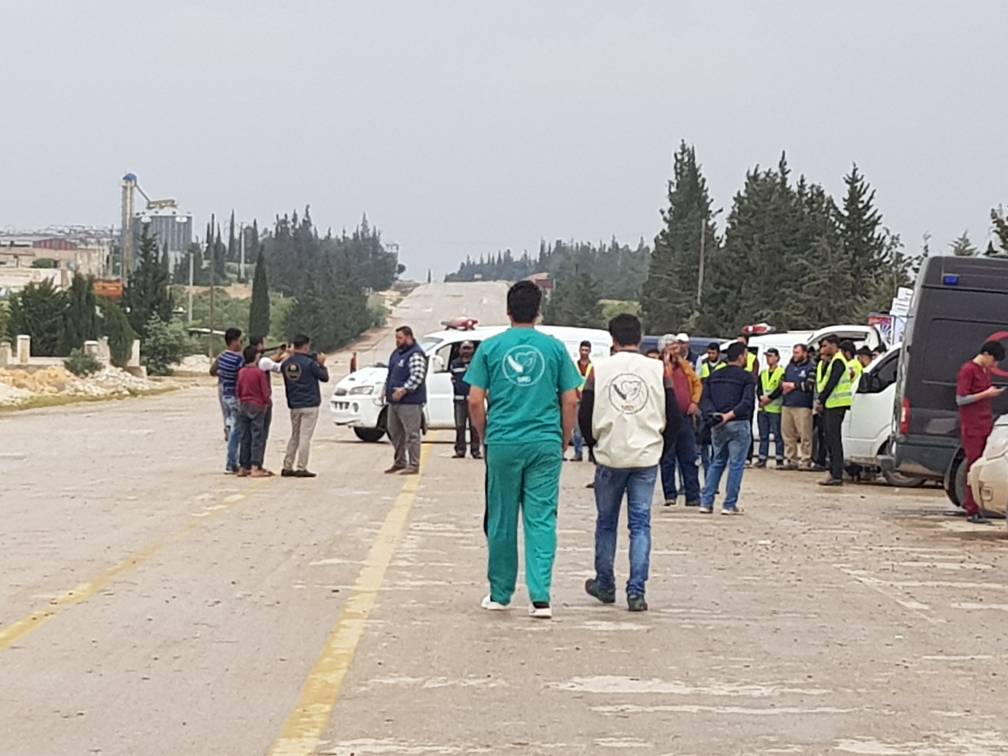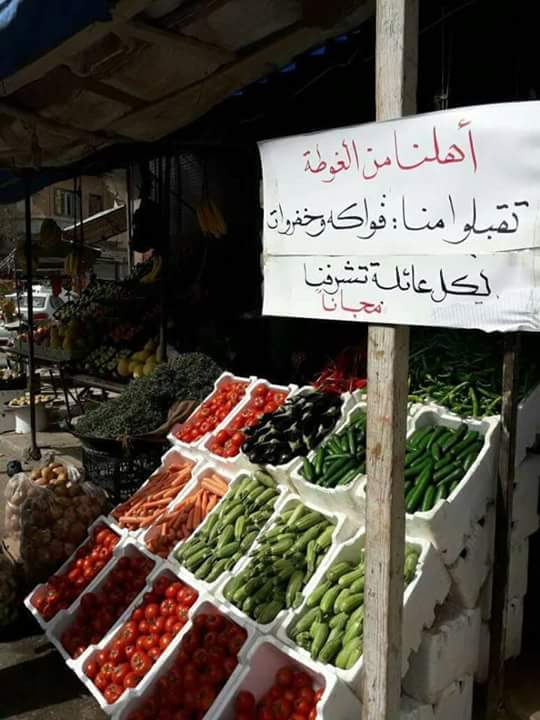Umm Salim (40) was not expecting the warm welcome and accolades she received on arrival in the northwestern Syrian province of Idlib. As soon as she and her relatives stepped off the bus, which was transporting scores of other displaced families from the Damascus suburbs of Eastern Ghouta, they encountered the big smiles and waving hands of Idlib residents. The local community invited the new arrivals into their homes. For a brief moment, the bitterness of displacement was forgotten.
The city and province of Idlib have absorbed vast numbers of people opposed to the regime of President Bashar al-Assad in recent years. The displaced have arrived in waves from all parts of the country. Idlib hospitality and emergency response mechanisms were dramatically tested in 2016 when armed opposition groups lost their grip on the strategic city of Aleppo. They were tested again this year when inhabitants of Eastern Ghouta fled their long-besieged suburb after the Syrian regime and its Russian ally launched a fierce military campaign to control the area. But local councils and civil associations in Idlib were on high alert and ready to spring into action.
The displaced in numbers
Obeida Dandoush (36) is a member of an emergency response coordination team active in northern Syria and a safety officer at Syria Relief & Development. He said that more than 48,654 displaced people from Eastern Ghouta arrived to Idlib and its countryside between mid-March and mid-April 2018. Many of them needed full support, from food and clothing to medical and psychological help. Dandoush added that about 1,500 wounded people came from Eastern Ghouta. Idlib took in 1,250 of them, while the northern Aleppo countryside areas received the remaining ones.

Dandoush also noted that his organization prepared an emergency response system that started in Qalaat al-Madiq, the area that local aid workers referred to as “point zero.” As part of a broader relief effort, humanitarian workers helped bring people to Idlib from Qalaat al-Madiq, a town in the western part of the Hama governorate, which had been designated as the entryway into the “liberated” opposition-held areas at the time of the Eastern Ghouta crisis.
The organization also deployed two teams specialized in family planning and another two tasked with providing psychological support.
“We sent each shelter an ambulance to transport the wounded to hospitals, two teams to offer psychological support and a mobile clinic, coordinating with other organizations to transport the wounded first to hospitals and then to shelters, “Dandoush told SyriaUntold, noting that the ambulances are still in use.
Dandoush highlighted that many of the cases were of children suffering from malnutrition due to the blockade and from diseases due to sitting in unequipped basements that were simply not fit for protracted inhabitation. These children are being supported through physical and psychological therapy activities, as well as with nutritional meals.
Idlib City, Jericho, Maarrat al-Numan, Atarib, Mizanaz shelter and the camps of northern Syria have the highest number of displaced people, according to the same source. Some have settled in other parts of Idlib governorate.
Welcome and shelter
Since the departure of civilians from Eastern Ghouta, humanitarian organizations, including Al-Wafaa for Relief and Development, Ghiras al-Nahda, Zeyd Bin Sabit Association, Rahma Humanitarian Foundation, Syrian Civil Defense, Syrian Nour Association, Violet Organization, Ataa Relief, Syria for Relief and Development Organization, Ihsan Organization, the Charity Cooperation Association (T3aawon) and others, continued this work. They are all independent, non-profit civil society organizations that are not affiliated with any political or military party.
In northern Syria and Idlib, temporary shelters were set up and equipped for the displaced to spend one day to three months until they are given a house or placed in a fixed camp. The latter are equipped with everything needed for long-term stays, including tents, shops and educational centers. The organizations also provided the equipment needed to transfer the displaced from pick-up locations to areas controlled by the Syrian opposition.
“We have been working on welcoming the displaced at their arrival point at Qalaat al-Madiq in Hama countryside, and we are transporting them to temporary shelters that were equipped before their arrival,” said Fouad Said Issa, 30, member of the board of trustees of the Violet Syria organization that operates in the Idlib and Hama countryside.
Issa was struck by the signs of “tiredness, fatigue, hunger and fear and the bad psychological state of the displaced who were arriving reflected their plight under the long siege.” He noted that the organization was not the only one working to address this suffering. Many other local organizations were present amid the blatant lack of international organizations.
The Charity Cooperation Association played a prominent role helping the displaced, especially in Jabal al-Zawiya area.
“As soon as those dear displaced arrived, we launched a relief campaign to offer them the essential needs,” the association’s manager Fadl al-Akel (36) said. “We tried hard to give them the welcoming they deserve and to make up for the woes of the siege, hunger and shelling they have endured for years.”
The Charity Cooperation Association provided more than 75 housing units with three months’ rent already paid, 32 solar energy panels, 150 food baskets, 1000 meals, 2000 bread bags, 100 cleaning baskets, 1000 blankets, 1000 clothing baskets as well as cash, foodstuff and meat.
An outpouring of voluntary initiatives
Organizations and associations were not the only ones helping out. Inhabitants made personal efforts to lend a hand as much as possible. Idlib’s citizens launched a series of initiatives to alleviate the suffering of the new arrivals. They collected donations, provided housing, covers, food and vegetables for the displaced. Some welcomed families from Eastern Ghouta in their own homes, and many owners of businesses like grocery stores, restaurants, furniture galleries and barber shops offered services and merchandise for free.

Issam al-Qaddour (45) hosted one displaced family in his home.
“I knew that relief organizations wouldn’t be able to meet the needs of all the displaced people. I performed my duties towards those who suffered all sorts of oppression and injustice under the tyrant regime that had no mercy on children or adults,” he said.
Qaddour has a two-story house. On one floor, he lives with his family, and on the other, lives the displaced family.
Omar al-Jundi (39) hails from Maarrat al-Numan and is among its richer citizens, having worked in car sales both before and during the revolution. He played a key role helping the displaced and urged others to do the same.
“Our duty is to help Ghouta’s citizens who have persisted and honorably defended the revolution for years,” he said.
Jundi took the personal initiative of equipping houses and sheltering dozens of families temporarily until they find suitable housing. He offered them meals, furniture and kitchen utensils.
Role of local councils and medical centers
Most local councils in northern Syria formed emergency response committees when Russia brokered evacuation deals with the main rebel factions in Eastern Ghouta in March.
“These committees allowed us to establish an emergency chamber in which all civil figures in the city participated. We began our work by visiting the arrival point in Qalaat al-Madiq which welcomes Ghouta’s citizens, and we divided the team into groups,” said the director of the of Saraqib local council, Al-Muthanna Mohammad (38).
The first group worked on registering the names of families that were willing to offer their houses for free to Ghouta’s citizens. They were distributed over the houses according to the number of family members. The second group accurately documented the names of families coming from Ghouta to meet their needs. The third group assessed the condition of houses to see if they are fit for living and to check the services. The fourth group offered health and medical services to the displaced. The fifth group oversaw the humanitarian relief warehouses in the city.
Mazen al-Saud (57), a doctor at the health directorate in Idlib, said that hospitals and medical centers were on full alert in the governorate to be able to accommodate all of Ghouta’s wounded. The less critical cases were admitted, and the critical ones were transferred to Turkey to receive proper treatment. A group of doctors from the city made personal initiatives and volunteered to welcome the sick and wounded displaced people in their private clinics.
Warm welcome, mixed feelings
Many of Eastern Ghouta’s displaced said that the kindness and help of Idlib inhabitants helped boost their morale, which was at rock bottom. Hayan al-Issa (42) was still reeling from the traumatic experiences he went through in his native Ghouta.
“We left the city with so much confusion. We were forced into a life in the unknown. We left behind our properties, houses and dreams. It was as though our souls were ripped out of our bodies. We felt something that I cannot describe—overwhelming sadness, despair and bitterness,” said Issa, a civilian with shaggy salt and pepper hair, melancholy eyes and a face that betrays the depth of his grief.
“But, as soon as we arrived to Idlib, we forgot the tiredness and the harshness of displacement thanks to the inhabitants’ warm welcome,” he added. “They made us feel at home.”
Issa lives in a house in Jisr al-Shughour city. He pays montly rent of 35,000 Syrian pounds (SYP), the equivalent of $75.
For her part, Umm Muhammad, a 41-year-old widow, expressed her gratitude to Idlib’s inhabitants and to the humanitarian organizations that helped her provide all the needs for her family that is made up of six children. She now lives in a house in Kafr Nabl city without paying any rent.
“The fear, hunger and terror we faced in Ghouta and the safety, care, welcome and interest we experienced in Idlib are worlds apart. We had low morale, but we now feel better among our beloved Idlib citizens,” she said.
Opportunistic exploitation
Some low-life opportunists tried to take advantage of the new arrivals' need for housing. They raised the rent despite the bad situation of Eastern Ghouta’s citizens who had been under siege for five years and could barely make ends meet.
This exploitation pushed some of the displaced not to disclose that they came from Eastern Ghouta to protect themselves. Haj Hussein al-Atassi, who is in his sixties, opted for this strategy. He expressed anger at the overcrowded conditions in shelters. When he wanted to rent a place for his big family, he was shocked at the high prices, running from 50,000 SYP ($110) and up. He claimed he was from Hama to get a more affordable rate of 20,000 SYP.
In the same context, social media activists called on real estate contractors to take it easy on Ghouta’s inhabitants and consider their situation rather than exploit them.
Idlib’s inhabitants reached 65.2 million, including 16.1 million internally displaced persons, as per the United Nations Office for the Coordination of Humanitarian Affairs.
Despite its overcrowded conditions and inability to take in more displaced, Idlib is expecting new convoys of forcibly displaced from other parts of Syria—including the outskirts of Homs, Damascus and Daraa—where military operations are underway. And where would all these people go if Idlib suffered the same fate as Eastern Ghouta? Is there another Syrian city capable of absorbing massive numbers of displaced people as Idlib has?




